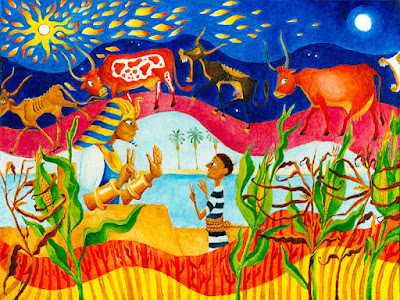Win! A Torah Trifecta! Abq Jew must tell you that this Shabbat, Shabbat Miketz, is not an ordinary, run-of-the-mill Shabbat, For not only is it Shabbat Miketz - it is also Rosh Hodesh Tevet, and it is also Shabbat Hanukkah. Which means -
For us Jews, Shabbat is approaching - and it's still Chanukah! In fact, this very Shabbat we will have the rare treat (and fulfill the extra mitzvot) of reading from ... not one; not two; but three (3) Sifrei Torah -
Three (3)! Yes, three (3)! How often, Abq Jew hears you ask, do we read from three (3) Sifrei Torah? Oddly enough (not really), Chabad.org has the answer.
Every year on the holiday of Simchat Torah, three different portions of the Torah are read during the morning service. a) V'zot Haberacha, the last portion of the Torah; b) the holiday maftir reading, discussing the day's Temple service; c) Bereishit, the first portion of the Torah.
If a synagogue has three Torah scrolls, then each of these portions is read from another scroll. If not, then one of the scrolls is quickly rolled from one portion to the next between readings.
There are three other times during the course of a year when, if various calendric variables fall in place, three portions of the Torah are read on the same day:
1. When Rosh Chodesh Tevet is on Shabbat [like this week]. Since the month of Tevet always begins during the holiday of Chanukah, in such a case there would be three readings: a) The weekly reading. b) The reading for Rosh Chodesh (head of the month). c) The holiday reading.
2. When the month of Adar (or the second month of Adar in a leap year) begins on Shabbat [not this year]. The extra portion of Shekalim is always read on the Shabbat immediately preceding the month of Adar, or on Rosh Chodesh Adar itself when it falls on Shabbat. On such a week we would read: a) The weekly Torah portion. b) The reading for Rosh Chodesh. c) The Shekalim reading.
3. Same thing when the month of Nissan begins on Shabbat [yes this year - on April 2]. The extra portion of Hachodesh is read on the Shabbat immediately preceding the month of Nissan, or on Rosh Chodesh Nissan when it falls on Shabbat. On such a Shabbat, the weekly Torah portion is read, in addition to the Rosh Chodesh and Hachodesh readings.
In any of these cases, three Torah scrolls are taken out of the Ark, if the synagogue has that many.
But what happens if the synagogue doesn't have that many Torah scrolls? Then the congregation gets to meet
 |
| Tircha D. Tzibura |
Tircha D. Tzibura is known throughout the Jewish world, even (especially?) Abq. Some say she has always been here; others, that she just arrived from the Coast. With her flaming red curls, sensible shoes, and half-asleep expression, she is easy to spot.
OK .... Tircha d'tzibura ("a burden on the congregation") is a Rabbinic / Talmudic expression that denotes an activity that takes longer than most people can bear, and that, therefore, should be avoided. While some claim that tircha d'tzibura cannot apply to shul on Shabbas - after all, where else ya gonna go? what else ya gotta do? - others are sure that it does.
The classic example: the many occasions during the year when we take two (or three!) Sifrei Torah (Torah scrolls) from the Ark, so we don't keep the congregation waiting while we roll the scroll back and forth to find the next reading.
"
There is only one Torah.





No comments:
Post a Comment